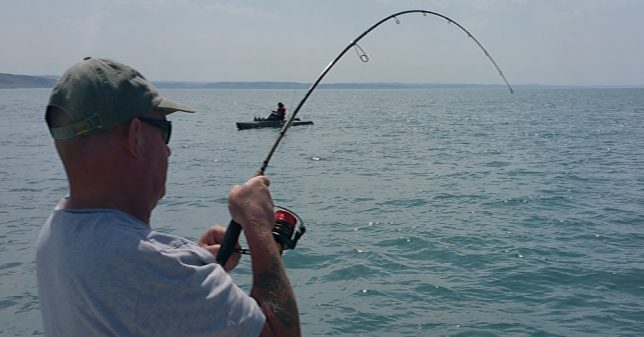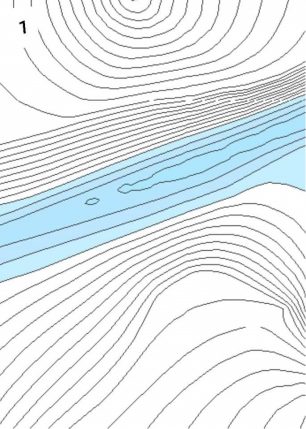Shallow Reef Boat Bass Fishing
With an increasing number of anglers taking to the water from boat, inflatable or kayak to target bass on lures, I thought I’d put this blog together on how I go about finding bass over shallow reefs.

For a start safety comes first! However you intend to be afloat make sure you carry the correct safety gear (Floatation device, VHF radio and an anchor as a minimum).
Locating A Reef
If your already on the water then your probably going to know about charts and plotters. If not then the Navionics app is a good place to start. The reefs I target start from the shore and head out for several miles so identifying them on a Navionics map is not a difficult task.

Picture 1 shows a reef running horizontally across the map, the contours indicate a change in depth with the blue areas highlighting the shallower ground. The closer together the contours then the steeper the structure. On some reefs the shallow zone will be green indicating that the area will dry over LW. If you can its certainly worth checking out from the shore at low water before taking your vessel over the area. A fish finder is a great tool for measuring the actual depth of water while drifting over the reef.

When you come close to your reef and the tide is flowing you’re most likely going to find a line of choppy or rough water at the front edge of the reef, where the tide is pushing up and over the reef, from the surrounding deeper water. What you visually see will change with different tidal flows and weather conditions. I prefer it when the reef line is showing some white water. This rougher reef line is the area where your going to find the bass sitting waiting to ambush smaller bait fish being pushed up by the faster turbulent water.
Drifting
The diagrams below show how I go about setting my drifts. I generally start further out and work my way down the reef into the shallow water. With the tide running left to right I will start the drift in the deeper water and cast towards the rougher reef line while drifting towards the target zone. All my casts are aimed at that front edge of rougher water and it’s where I will hit 90% of my bass. Once the drift is over I will always turn the boat out and go back around the area I just drifted and stop at the start point of the second drift location. I never run the outboard over the the ground I intend to fish but on Kayaks I’m sure you’ll be fine.

The water depths I’m fishing in, range from around 18ft in the deeper water down to 3ft over the top of the reef. Lure selection for me will be anything that swims down to 900mm max. Zonks and Hounds are favourite for this type of fishing, both cast exceptionally well and cover a lot of ground and they both bite well in the rougher water. Top water lures have also proved very successful over the years as well.
Once I find bass on a certain drift I’ll quite often be able to carry on setting the same drift and stay on the fish for a long period of time. A fast retrieve rate has always worked well in the past and quite often you’ll find numbers of bass competing for lures. Hits will mostly be hard and fast.
In the past I’ve found that locating structures in front of the reef line has been very productive and given me some of my bigger bass. These structures (boulders in my case) produce a back eddy caused by the the water been pushed around them as the tide races towards the reef. It’s certainly worth casting beyond these and retrieving behind them. Even though its always the front edge / top of a reef I’ve found most productive, it’s always worth working structures further back as you drift past.
Just remember that reefs are a dangerous place and throw up many obstacles so ensure you do your homework. Build up your knowledge over time and confidence will follow.
Author: Sean Jukes
Feature Photos: Sean Jukes
© Bass Anglers’ Sportfishing Society 2021